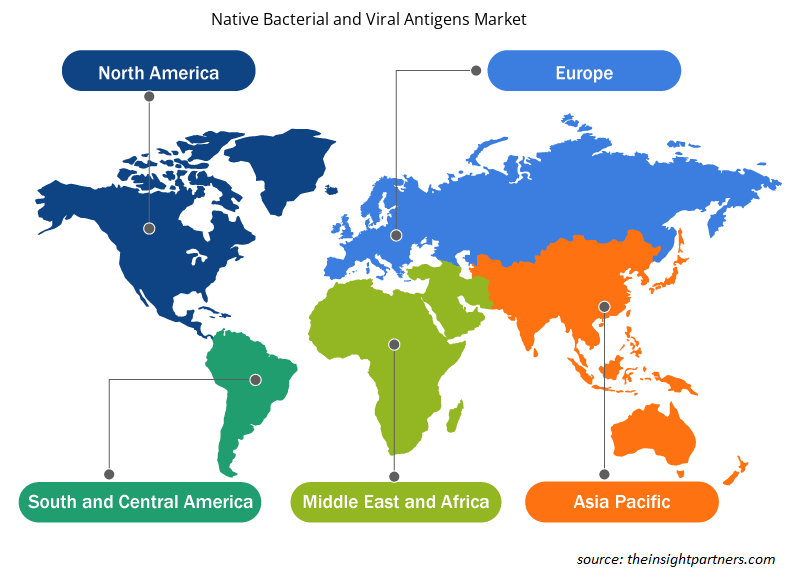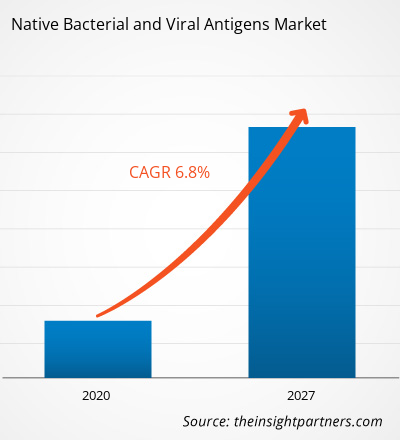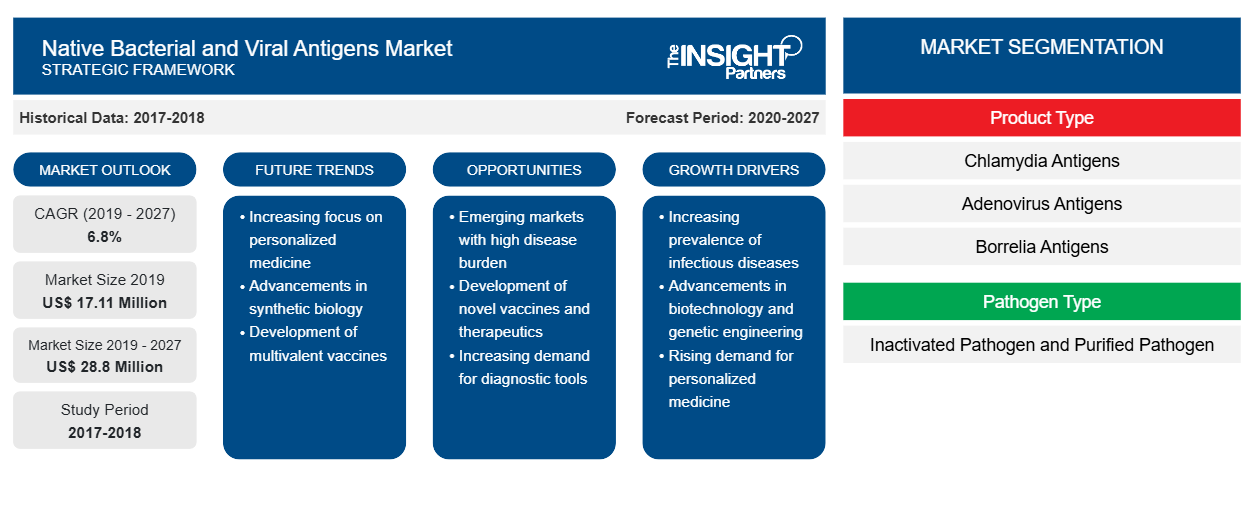Si prevede che il mercato degli antigeni batterici e virali nativi raggiungerà i 28.801,15 mila dollari USA entro il 2027, rispetto ai 17.105,05 mila dollari USA del 2019; si stima che crescerà a un CAGR del 6,8% dal 2020 al 2027.
Gli antigeni nativi vengono estratti nella loro forma naturale dalle rispettive fonti. Poiché subiscono le consuete modifiche in vivo, una volta isolati, mostrano una stretta somiglianza con la complessa struttura tridimensionale che presentano nell'ospite. Nel caso degli antigeni proteici, queste modifiche possono includere alterazioni post-traduzionali come la scissione delle proteine precursori, la formazione di legami disolfuro e l'aggiunta di gruppi a basso peso molecolare tramite processi come la glicosilazione o la fosforilazione. Il mercato globale degli antigeni batterici e virali nativi è guidato da fattori come il crescente utilizzo di antigeni microbici nativi nella diagnostica e nella terapia e la crescente prevalenza di malattie infettive. Tuttavia, le limitazioni associate agli antigeni nativi come costi elevati, bassi livelli di produzione di antigeni e difficoltà di ampliamento ostacolano la crescita del mercato. Tuttavia, i mercati emergenti stanno creando opportunità di crescita per gli operatori del mercato.
Personalizza questo report in base alle tue esigenze
Riceverai la personalizzazione gratuita di qualsiasi report, comprese parti di questo report, o analisi a livello nazionale, pacchetto dati Excel, oltre a usufruire di grandi offerte e sconti per start-up e università
- Scopri le principali tendenze di mercato in questo rapporto.Questo campione GRATUITO includerà analisi di dati che spaziano dalle tendenze di mercato alle stime e alle previsioni.
Approfondimenti di mercato
Aumento dell'uso di antigeni microbici nativi nella diagnostica e nella terapia
Gli antigeni sono le biomolecole in grado di innescare la risposta immunitaria nel corpo ospite attraverso l'attivazione dei linfociti. Gli antigeni batterici sono utilizzati nello sviluppo di vari tipi di anticorpi nei laboratori di ricerca per il miglioramento del sistema immunitario. Inoltre, gli antigeni batterici sono ampiamente utilizzati anche in test immunodiagnostici come ELISA.
La panoramica delle librerie di antigeni nativi ha portato allo sviluppo di potenti anticorpi di neutralizzazione contro varie infezioni batteriche e virali. Gli antigeni nativi vengono estratti nella loro forma naturale da una fonte corrispondente. C'è una forte domanda per un gran numero di antigeni nativi, specialmente nella diagnostica in vitro e nella ricerca sui vaccini. Secondo vari studi scientifici, gli antigeni ricombinanti presentano problemi di solubilità e aggregazione. Inoltre, l'associazione di antigeni ricombinanti con entità non proteiche è anche diversa e talvolta carente in termini di prestazioni rispetto agli antigeni nativi.
Con la recente epidemia di COVID-19, le aziende stanno sviluppando antigeni SARS-CoV-2 commerciali per supportare la formulazione del vaccino e la ricerca e sviluppo per rafforzare la diagnosi e la terapia della malattia. A febbraio 2020, la Native Antigen Company è diventata la prima azienda a fornire commercialmente i nuovi antigeni del coronavirus, utilizzando il sistema di espressione proprietario VirtuE (HEK293) dell'azienda. Pertanto, il crescente utilizzo di antigeni nativi, che supporta efficacemente la diagnosi e la terapia di varie condizioni mediche, aumenta la crescita del mercato degli antigeni e degli anticorpi batterici nativi.
Informazioni basate sul tipo di prodotto
Il mercato degli antigeni batterici e virali nativi, in base al tipo di prodotto, è segmentato in antigeni della clamidia, antigeni dell'adenovirus, antigeni della borrelia, antigeni del clostridium, antigeni del virus chikungunya e antigeni del virus dengue. Il segmento degli antigeni della clamidia ha detenuto la quota maggiore del mercato nel 2019 e si prevede che il mercato per lo stesso crescerà al CAGR più elevato durante il periodo di previsione. La crescita del mercato per questo segmento è attribuita alla facile reperibilità di questi antigeni, con la maggior parte degli operatori del mercato che offrono commercialmente questi antigeni nelle forme native. Inoltre, si prevede che l'uso di antigeni della clamidia negli istituti di ricerca e nei laboratori per lo sviluppo di vaccini e test diagnostici in vitro (IVD) spingerà ulteriormente la crescita del mercato per questo segmento.
Approfondimenti basati sul tipo di agente patogeno
In base al tipo di patogeno, il mercato degli antigeni batterici e virali nativi è segmentato in patogeno inattivato e patogeno purificato. Il segmento dei patogeni inattivati ha detenuto una quota maggiore del mercato nel 2019 e si stima che registrerà un CAGR più elevato durante il periodo di previsione.
Approfondimenti basati sulle applicazioni
In base all'applicazione, il mercato degli antigeni batterici e virali nativi è segmentato in test ELISA, immunoassay, SDS-PAGE, emoagglutinazione e agglutinazione. Il segmento ELISA ha detenuto la quota maggiore del mercato nel 2019 e si stima che registrerà il CAGR più elevato nel periodo 2020-2027.
Informazioni basate sull'utente finale
In base all'utente finale, il mercato degli antigeni batterici e virali nativi è segmentato in laboratori e centri diagnostici e istituti accademici e di ricerca. Il segmento dei laboratori e centri diagnostici ha detenuto la quota maggiore del mercato nel 2019 e si stima che registrerà il CAGR più elevato dal 2020 al 2027.
Lanci di prodotti e approvazioni sono le strategie comunemente adottate dalle aziende per espandere la loro presenza globale e i loro portafogli di prodotti; queste strategie le aiutano a soddisfare la crescente domanda dei consumatori. La collaborazione è una delle principali strategie adottate dalle aziende che operano nel mercato degli antigeni batterici e virali nativi per ampliare la base clienti in tutto il mondo, il che consente loro anche di mantenere il loro marchio a livello globale.
Approfondimenti regionali sul mercato degli antigeni batterici e virali nativi
Le tendenze regionali e i fattori che influenzano il mercato degli antigeni batterici e virali nativi durante il periodo di previsione sono stati ampiamente spiegati dagli analisti di Insight Partners. Questa sezione discute anche i segmenti e la geografia del mercato degli antigeni batterici e virali nativi in Nord America, Europa, Asia Pacifico, Medio Oriente e Africa e America meridionale e centrale.

- Ottieni i dati specifici regionali per il mercato degli antigeni batterici e virali nativi
Ambito del rapporto di mercato sugli antigeni batterici e virali nativi
| Attributo del report | Dettagli |
|---|---|
| Dimensioni del mercato nel 2019 | 17,11 milioni di dollari USA |
| Dimensioni del mercato entro il 2027 | 28,8 milioni di dollari USA |
| CAGR globale (2019 - 2027) | 6,8% |
| Dati storici | 2017-2018 |
| Periodo di previsione | 2020-2027 |
| Segmenti coperti | Per tipo di prodotto
|
| Regioni e Paesi coperti | America del Nord
|
| Leader di mercato e profili aziendali chiave |
|
Densità degli attori del mercato degli antigeni batterici e virali nativi: comprendere il suo impatto sulle dinamiche aziendali
Il mercato degli antigeni batterici e virali nativi sta crescendo rapidamente, spinto dalla crescente domanda degli utenti finali dovuta a fattori quali l'evoluzione delle preferenze dei consumatori, i progressi tecnologici e una maggiore consapevolezza dei benefici del prodotto. Con l'aumento della domanda, le aziende stanno ampliando le loro offerte, innovando per soddisfare le esigenze dei consumatori e capitalizzando sulle tendenze emergenti, il che alimenta ulteriormente la crescita del mercato.
La densità degli operatori di mercato si riferisce alla distribuzione di aziende o società che operano in un particolare mercato o settore. Indica quanti concorrenti (operatori di mercato) sono presenti in un dato spazio di mercato in relazione alle sue dimensioni o al valore di mercato totale.
Le principali aziende che operano nel mercato degli antigeni batterici e virali nativi sono:
- LABORATORI BIO-RAD INC.
- Microbix Biosistemi
- Immunologici SERION
- Aalto Bio Reagenti Ltd
- Enzo Life Sciences Inc.
Disclaimer : le aziende elencate sopra non sono classificate secondo un ordine particolare.

- Ottieni una panoramica dei principali attori del mercato degli antigeni batterici e virali nativi
Mercato degli antigeni batterici e virali nativi – per tipo di prodotto
- Antigeni della clamidia
- Antigeni dell'adenovirus
- Antigeni della Borrelia
- Antigeni del virus Chikungunya
- Antigeni del Clostridium
- Antigeni del virus Dengue
Mercato degli antigeni batterici e virali nativi – per tipo di patogeno
- Patogeno inattivato
- Patogeno purificato
Mercato degli antigeni batterici e virali nativi – per applicazione
- Elisa
- Immunoanalisi
- SDS-PAGINA
- Emoagglutinazione
- Test di agglutinazione
Mercato degli antigeni batterici e virali nativi – di EndUser
- Laboratori e centri diagnostici
- Istituti accademici e di ricerca
Mercato degli antigeni batterici e virali nativi – per area geografica
America del Nord
- NOI
- Canada
- Messico
Europa
- Francia
- Germania
- Italia
- Regno Unito
- Spagna
- Resto d'Europa
Asia Pacifico (APAC)
- Cina
- India
- Corea del Sud
- Giappone
- Australia
- Resto dell'Asia Pacifica
Medio Oriente e Africa (MEA)
- Sudafrica
- Arabia Saudita
- Emirati Arabi Uniti
- Resto del Medio Oriente e Africa
America del Sud e Centro
- Brasile
- Argentina
- Resto del Sud America
Profili aziendali
- LABORATORI BIO-RAD INC.
- Microbix Biosistemi
- Immunologici SERION
- Aalto Bio Reagenti Ltd
- Enzo Life Sciences Inc.
- Jena Bioscience GmbH
- LABORATORI ROSS SUD
- La società Native Antigen
- Diagnostica creativa
- TRINA BIOREATTIVI AG
- Analisi storica (2 anni), anno base, previsione (7 anni) con CAGR
- Analisi PEST e SWOT
- Valore/volume delle dimensioni del mercato - Globale, Regionale, Nazionale
- Industria e panorama competitivo
- Set di dati Excel
Report recenti
Testimonianze
Motivo dell'acquisto
- Processo decisionale informato
- Comprensione delle dinamiche di mercato
- Analisi competitiva
- Analisi dei clienti
- Previsioni di mercato
- Mitigazione del rischio
- Pianificazione strategica
- Giustificazione degli investimenti
- Identificazione dei mercati emergenti
- Miglioramento delle strategie di marketing
- Aumento dell'efficienza operativa
- Allineamento alle tendenze normative





















 Ottieni un campione gratuito per - Mercato degli antigeni batterici e virali nativi
Ottieni un campione gratuito per - Mercato degli antigeni batterici e virali nativi